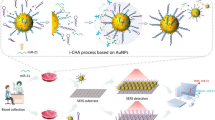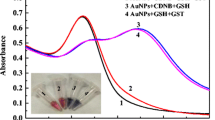Abstract
A colorimetric assay for ATP is described that uses a strategy that combines the concept of split Mg(II)-dependent DNAzyme, split aptamer, and hybridization-induced aggregation of gold nanoparticles (AuNPs). Both ATP aptamer and Mg(II)-dependent DNAzyme are split into two fragments which are allocated to two well-designed DNA probes. The probes also possess mutually complementary stem sequences and spacer sequences. In the presence of ATP, the separated DNAzyme sequences in the two probes assemble via the synchronous recognition of ATP with two fragments of the aptamer. Then, the activated DNAzyme catalyzes multiple cycles of the cleavage of its substrate DNA sequence. The latter acts as a linker and induces the aggregation of two types of ssDNA-modified AuNP through the hybridization between the complementary sequences. Thus, the color of the AuNP solution remains red. However, in the absence of ATP, the detached aptamer cannot induce the assembly of DNAzyme to cleave the linker DNA. This results in the aggregation of AuNP and a concomitant color transition from red to purple. This ATP assay, performed at a wavelength of 530 nm, has a linear detection range that extends from 10 pM to 100 nM, with a detection limit of 5.3 pM. It was applied to the detection of ATP in human serum. Conceivably, the strategy has a wide scope in that it may be applied to the colorimetric detection of various other analytes through the split aptamer configuration.

Schematic presentation of colorimetric assay for adenosine triphosphate (ATP) based on the use of a split Mg(II)-dependent DNAzyme, a split aptamer, and by exploiting the hybridization-induced aggregation of gold nanoparticles that leads to a color change from red to purple




Similar content being viewed by others
References
Tedsana W, Tuntulani T, Ngeontae W (2013) A highly selective turn-on ATP fluorescence sensor based on unmodified cysteamine capped CdS quantum dots. Anal Chim Acta 783(11):6573
Bell PD, Komlosi P, Zhang ZR (2009) ATP as a mediator of macula densa cell signalling. Purinergic Signal 5(4):461–471
Bell CJ, Manfredi G, Griffiths EJ, Rutter GA (2007) Luciferase expression for ATP imaging: application to cardiac myocytes. Methods Cell Biol 80:341–352
Gourine AV, Llaudet E, Dale N, Spyer KM (2005) ATP is a mediator of chemosensory transduction in the central nervous system. Nature 436(7047):108–111
Moreno-Sánchez R, Marín-Hernández A, Saavedra E, Pardo JP, Ralph SJ, Rodríguez-Enríquez S (2014) Who controls the ATP supply in cancer cells? Biochemistry lessons to understand cancer energy metabolism. Int J Biochem Cell Biol 50(1):10–23
Jiang G, Zhu W, Xin S, Lei X, Li X, Rui W, Liu C, Zhou X (2017) Colorimetric and visual determination of adenosine triphosphate using a boronic acid as the recognition element, and based on the deaggregation of gold nanoparticles. Microchim Acta 184(11):4305–4312
Qu F, Sun C, Lv X, You J (2018) A terbium-based metal-organic framework@gold nanoparticle system as a fluorometric probe for aptamer based determination of adenosine triphosphate. Microchim Acta 185(8):359
Cheng X, Cen Y, Xu G, Wei F, Shi M, Xu X, Sohail M, Hu Q (2018) Aptamer based fluorometric determination of ATP by exploiting the FRET between carbon dots and graphene oxide. Microchim Acta 185(2):144
Luo J, Shen X, Li B, Li X, Zhou X (2018) Signal amplification by strand displacement in a carbon dot based fluorometric assay for ATP. Microchim Acta 185(8):392
Liu X, Lin B, Yu Y, Cao Y, Guo M (2018) A multifunctional probe based on the use of labeled aptamer and magnetic nanoparticles for fluorometric determination of adenosine 5′-triphosphate. Microchim Acta 185(4):243
Kurdi RE, Patra D (2018) Nanosensing of ATP by fluorescence recovery after surface energy transfer between rhodamine B and curcubit[7]uril-capped gold nanoparticles. Microchim Acta 185(7):349
Jing L, Yi L (2000) A highly sensitive and selective catalytic DNA biosensor for Lead ions. Jamchemsoc 122(42):10466–10467
Mu Q, Liu G, Yang D, Kou X, Cao N, Tang Y, Miao P (2018) Ultrasensitive detection of DNA based on exonuclease III-assisted recycling amplification and DNAzyme motor. Bioconjug Chem 29:3527–3531
Zuo X, Xiao Y, Plaxco KW (2009) High specificity, electrochemical sandwich assays based on single aptamer sequences and suitable for the direct detection of small-molecule targets in blood and other complex matrices. J Am Chem Soc 131(20):6944–6945
Liu J, Bai W, Niu S, Zhu C, Yang S, Chen A (2014) Highly sensitive colorimetric detection of 17β-estradiol using split DNA aptamers immobilized on unmodified gold nanoparticles. Sci Rep 4:7571
Zhao T, Liu R, Ding X, Zhao J, Yu H, Wang L, Xu Q, Wang X, Lou X, He M (2015) Nanoprobe-enhanced, split aptamer-based electrochemical sandwich assay for ultrasensitive detection of small molecules. Anal Chem 87(15):7712–7719
Zhu C, Zhao Y, Yan M, Huang Y, Yan J, Bai W, Chen A (2016) A sandwich dipstick assay for ATP detection based on split aptamer fragments. Anal Bioanal Chem 408(15):4151–4158
Li Q, Wang Y-D, Shen G-L, Tang H, Yu R-Q, Jiang J-H (2015) Split aptamer mediated endonuclease amplification for small-molecule detection. Chem Commun 51(20):4196–4199
Mirkin CA, Letsinger RL, Mucic RC, Storhoff JJ (1996) A DNA-based method for rationally assembling nanoparticles into macroscopic materials. Nature 382(6592):607–609
Mairal T, Özalp VC, Sánchez PL, Mir M, Katakis I, O’Sullivan CK (2008) Aptamers: molecular tools for analytical applications. Anal Bioanal Chem 390(4):989–1007
Kent AD, Spiropulos NG, Heemstra JM (2013) General approach for engineering small-molecule-binding DNA split aptamers. Anal Chem 85(20):9916–9923
Schlosser K, Li Y (2010) A versatile endoribonuclease mimic made of DNA: characteristics and applications of the 8-17 RNA-cleaving DNAzyme. Chembiochem 11(7):866–879
Juewen L, Yi L (2007) A DNAzyme catalytic beacon sensor for paramagnetic Cu2+ ions in aqueous solution with high sensitivity and selectivity. J Am Chem Soc 129(32):9838–9839
Yong H, Jia C, Shulin Z, Ming S, Zhen-Feng C, Hong L (2013) Label-free colorimetric aptasensor based on nicking enzyme assisted signal amplification and DNAzyme amplification for highly sensitive detection of protein. Anal Chem 85(9):4423–4430
Gu J-A, Lin Y-J, Chia Y-M, Lin H (2013) Colorimetric and bare-eye determination of fluoride using gold;nanoparticle agglomeration probes. Microchim Acta 180(9–10):801–806
Chao L, Wei L, Liu X, Lin L, Li G (2014) Ultrasensitive detection of lead ion based on target induced assembly of DNAzyme modified gold nanoparticle and graphene oxide. Anal Chim Acta 831(23):60–64
Acknowledgements
This work was supported by the Science and Technology Development Foundation of Nanjing Medical University (2017NJMU175), The National Key Research and Development Program: The key technology of palliative care and nursing for cancer patients (ZDZX2017ZL-01) and The High Level Innovation Team of Nanjing Medical University (JX102GSP201727).
Author information
Authors and Affiliations
Corresponding authors
Ethics declarations
The author(s) declare that they have no competing interests.
Additional information
Publisher’s note
Springer Nature remains neutral with regard to jurisdictional claims in published maps and institutional affiliations.
Electronic supplementary material
ESM 1
(DOC 133 kb)
Rights and permissions
About this article
Cite this article
Zhu, S., Wang, X., Jing, C. et al. A colorimetric ATP assay based on the use of a magnesium(II)-dependent DNAzyme. Microchim Acta 186, 176 (2019). https://doi.org/10.1007/s00604-019-3244-9
Received:
Accepted:
Published:
DOI: https://doi.org/10.1007/s00604-019-3244-9




